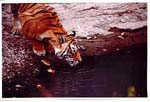News and Views
Susan Sharma
NEWS…………
 The new look homepage of IndianWildlifeclub.com has user friendly menus and a site map to help navigate better. Hope the page is more pleasing to the eye as well. Pictures
by our talented photographers have been converted into interesting screen savers, wall papers and posters which are available as free downloads to our registered members. Our “Wildscapes” module is undergoing a transformation too.
The new look homepage of IndianWildlifeclub.com has user friendly menus and a site map to help navigate better. Hope the page is more pleasing to the eye as well. Pictures
by our talented photographers have been converted into interesting screen savers, wall papers and posters which are available as free downloads to our registered members. Our “Wildscapes” module is undergoing a transformation too.
We would like members to give their feedback on the changes. Suggestions are also welcome. If you like the web site, please ask your friends to register too. Just use the
‘recommend it’ button on the main page to invite friends.
There are a large number of independent filmmakers in India who are making issue based films on Indian wildlife and environment related issues. You can read synopsis of
some of these films on our video page. We have also decided to highlight the synopsis of one film per month on the home page. Unfortunately these films are seldom screened or telecast for the general public. WWF ( I ) arranges screenings at Delhi regularly.
But these films ought to reach a larger audience. Please spread the word through ‘Wildbytes’ ezine if you know of screenings/telecast of any of these films.
The recent happenings at Ranthambhore National Park wherein people and cattle laid siege to the park last month have brought the issue of protecting our National Parks
to the fore once again. Given below is an appeal drafted by us which please address ( by snail mail) to concerned authorities of your area as individual appeals from concerned citizens.
( The picture above is that of “Machali’,
a tigress in Ranthambhore photographed by Aditya Singh)
------------------------------------------------------------------------------------------------------
Respected Sir,
India as a country is blessed with a population which has, since time immemorial lived life in partnership with nature. Most of us consider the rich bio
diversity of this country as the biggest wealth of this country. We have fortunately had democratic leaders who have realized the need for preserving these priceless natural treasures for posterity.
The Wildlife Protection act of 1972 which spelt out clearly the legal and administrative details for preserving wildlife and environment through declared
sanctuaries and national parks, was a great step in this direction.
Of late we have had instances of the Nation's scenic treasures becoming monuments to administrative chaos. Scattered for support among various Government
departments and chronically short of staff and funds, we have had ugly incidents happening in Ranthambhore National Park, to quote a recent event. Though legally banned, poaching of wildlife by shortsighted groups continue.
NGOs and concerned private citizens/organizations have but limited roles to play in a subject which is as vast as the country itself - the subject of protecting
our bio-diversity.
This is an appeal to you, as District Collector of, ( Prime Minister of India), (Chief Minister of ) to boldly implement the law of the land.
The millions on this country will ever
be grateful to you.
And VIEWS…………..
" I didn't know a tiger's skin was worth anything".
" It is worth more than our skins,' said Ramu knowingly. "It will fetch six hundred rupees. Who would pay that much for one of us?"
"Our fathers would."
"True--if they had the money."
"If my father sold his fields, he would get more than six hundred rupees."
"True-but if he sold his fields, none of you would have anything to eat. A man needs land as much as a tiger needs a jungle."
Excerpt from Page 108, “PANTHER'S MOON and Other Stories”
by RUSKIN BOND
A puffin Book